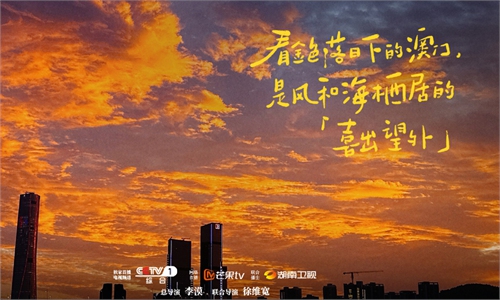ARTS / CULTURE & LEISURE
Personalization of film consumption and its untapped potential
Editor's Note:
As China's cinemas grapple with young viewers flocking to short videos, this piece by Sun Chengjian, a deputy director at the Film and Television Research Institute at the Chinese National Academy of Arts, highlights a pivotal shift: Film consumption is evolving toward personalization, yet algorithmic dominance risks homogenization. He argues that "movie-watching +" experiences, which blend thematic spaces, tech-driven viewing and serendipitous encounters, can revive cinemas. By balancing individual aesthetics with collective cultural resonance, as seen in venues like the China Science and Technology Museum, the industry can navigate the tension between niche appeal and mass scale.

In recent years, China's cinema industry has faced a growing exodus of young movie-goers, while short-video platforms have surged in popularity.
According to the China Internet Audio Visual Development Research Report (2024), the average daily viewing time for short video users reached 151 minutes in 2023 and rose to 156 minutes in 2024, a 3.1 percent increase year-on-year.
While many attribute declining theater attendance to competition from streaming media and bite-sized content, this oversimplified narrative ignores a critical shift - the rise of personalized film consumption in an era increasingly dominated by data and algorithms.
The digital age has redefined visual culture through data-driven recommendation systems that construct users' "portraits" based on viewing habits, engagement metrics and even eye-tracking data.
Yet these profiles, rooted in attention economy logic, paradoxically erase the human subject.
Algorithms prioritize patterns from past behaviors, assuming "the future will mirror the past," but fail to account for evolving emotional, cultural and value-driven motivations behind consumption choices. This has created a dual-edged reality: While claiming to cater to individuality, algorithmic systems homogenize content production and viewing experiences. For instance, formulaic genres and standardized theater formats - from IMAX's technical spectacle to rigid release schedules - have dulled audience expectations.
Meanwhile, short-video platforms thrive on dopamine-driven immediacy but cater predominantly to less educated demographics. This can be seen in the fact that 37.9 percent of micro-drama users only have a junior high education or below, per Endata's 2025 Short-Form Content Consumption Report.
In contrast, cinema's core audiences remain mid-to-high educated groups, whose viewing habits often blend aesthetic discernment with a desire for unscripted cultural encounters, which shows a resistance to being defined by algorithmic curation.

Some may argue this guidance contradicts personalization, but true personalization is the consumption freedom and taste preference based on aesthetic quality, not mere novelty.
For young audiences, what truly drives them to cinemas is not the "action" on screen, but the "action" in their hearts. When screen and mind align, personalized consumption gains meaning.
Film consumption is not merely transactional; it's a negotiation between personal identity and collective consciousness.
Sociologist Émile Durkheim's concept of "collective effervescence" finds modern expression here: Audiences seek films that resonate with both private emotions and shared social values.
Yet algorithms, fixated on quantifiable metrics, struggle to engage this dialectic. Overreliance on data risks creating a false consensus - a "personalization trap" that substitutes genuine social sentiment with engineered trends.
True personalization, then, lies not in novelty for its own sake but in preserving spaces for "serendipity," or unexpected encounters between viewers and content. This "aesthetics of chance" challenges industrialized content production, emphasizing the value of uncertainty in artistic reception.
"Aesthetics of chance" extend beyond the screen to viewing spaces.
China's cinema infrastructure, with more than 90,000 screens (the most in the world), has fallen into homogenization. Standardized styles and functions are erasing regional cultural symbols.
Despite the trend of film-tourism integration, cinemas remain excluded, offering no "cultural encounters" that enhance viewing experiences.
Today's personalized film consumption is no longer single-dimensional but a comprehensive model that integrates unique cultural spaces, non-linear time, diverse audio-visual content and even thematic consumption.
While traditional theaters stagnate, institutions like the China Science and Technology Museum (CSTM) offer a blueprint for reinvention.
Its thematic theaters - featuring dome screens, 4D effects and 20-40-minute science films - attract over 1 million annual visitors, with tickets often selling out during holidays.
Though not classified as commercial cinemas, these venues thrive by merging education, technology, and entertainment into a cohesive "cinema+" experience.
The museum's success offers three insights about shifting from pure content demand to comprehensive "movie-watching +" experiences.
First, personalized consumption has evolved into thematic, integrated experiences. While quality content remains key, thematic venues can aggregate audiences.
Second, "technologized viewing" at CSTM provides unparalleled audio-visual experiences, driving audience motivation.
Third, short-format films (20-40 minutes) cater to fragmented schedules, countering short-video dominance without sacrificing narrative depth.
Endata data also reveals that 63 percent of theater visits are motivated by social or experiential factors - IP merchandise and social check-ins - rather than pure content consumption. This shift from "product" to "scene" consumption demands hybrid strategies.
Yet challenges persist. To achieve economies of scale, Chinese films require at least 280 million yuan ($38.87 million) box office, or 8 million admissions, per the 2023 Film Industry White Paper. As such, balancing niche personalization with mass appeal still remains precarious.
By fostering "cinema+" ecosystems that integrate thematic spaces, technological innovation and flexible formats, the industry can reclaim its role as a cultural encounter that resonates with both individual hearts and collective consciousness.
In conclusion, how to find an effective path for the development of China's film industry that finds a balance between ideal dissemination and industrial scale constraints, as well as between the transformation of viewers' consumption motivations and industrial adaptation strategies, may be an important issue that we need to face and consider in the construction of a strong film nation.
The author is a deputy director at the Film and Television Research Institute at the Chinese National Academy of Arts
As China's cinemas grapple with young viewers flocking to short videos, this piece by Sun Chengjian, a deputy director at the Film and Television Research Institute at the Chinese National Academy of Arts, highlights a pivotal shift: Film consumption is evolving toward personalization, yet algorithmic dominance risks homogenization. He argues that "movie-watching +" experiences, which blend thematic spaces, tech-driven viewing and serendipitous encounters, can revive cinemas. By balancing individual aesthetics with collective cultural resonance, as seen in venues like the China Science and Technology Museum, the industry can navigate the tension between niche appeal and mass scale.

Sun Chengjian
In recent years, China's cinema industry has faced a growing exodus of young movie-goers, while short-video platforms have surged in popularity.
According to the China Internet Audio Visual Development Research Report (2024), the average daily viewing time for short video users reached 151 minutes in 2023 and rose to 156 minutes in 2024, a 3.1 percent increase year-on-year.
While many attribute declining theater attendance to competition from streaming media and bite-sized content, this oversimplified narrative ignores a critical shift - the rise of personalized film consumption in an era increasingly dominated by data and algorithms.
The digital age has redefined visual culture through data-driven recommendation systems that construct users' "portraits" based on viewing habits, engagement metrics and even eye-tracking data.
Yet these profiles, rooted in attention economy logic, paradoxically erase the human subject.
Algorithms prioritize patterns from past behaviors, assuming "the future will mirror the past," but fail to account for evolving emotional, cultural and value-driven motivations behind consumption choices. This has created a dual-edged reality: While claiming to cater to individuality, algorithmic systems homogenize content production and viewing experiences. For instance, formulaic genres and standardized theater formats - from IMAX's technical spectacle to rigid release schedules - have dulled audience expectations.
Meanwhile, short-video platforms thrive on dopamine-driven immediacy but cater predominantly to less educated demographics. This can be seen in the fact that 37.9 percent of micro-drama users only have a junior high education or below, per Endata's 2025 Short-Form Content Consumption Report.
In contrast, cinema's core audiences remain mid-to-high educated groups, whose viewing habits often blend aesthetic discernment with a desire for unscripted cultural encounters, which shows a resistance to being defined by algorithmic curation.

Illustration: Chen Xia/GT
However, for socially topical films, the viewing experiences of middle-to-higher educated audiences can guide and radiate to lower-educated groups.Some may argue this guidance contradicts personalization, but true personalization is the consumption freedom and taste preference based on aesthetic quality, not mere novelty.
For young audiences, what truly drives them to cinemas is not the "action" on screen, but the "action" in their hearts. When screen and mind align, personalized consumption gains meaning.
Film consumption is not merely transactional; it's a negotiation between personal identity and collective consciousness.
Sociologist Émile Durkheim's concept of "collective effervescence" finds modern expression here: Audiences seek films that resonate with both private emotions and shared social values.
Yet algorithms, fixated on quantifiable metrics, struggle to engage this dialectic. Overreliance on data risks creating a false consensus - a "personalization trap" that substitutes genuine social sentiment with engineered trends.
True personalization, then, lies not in novelty for its own sake but in preserving spaces for "serendipity," or unexpected encounters between viewers and content. This "aesthetics of chance" challenges industrialized content production, emphasizing the value of uncertainty in artistic reception.
"Aesthetics of chance" extend beyond the screen to viewing spaces.
China's cinema infrastructure, with more than 90,000 screens (the most in the world), has fallen into homogenization. Standardized styles and functions are erasing regional cultural symbols.
Despite the trend of film-tourism integration, cinemas remain excluded, offering no "cultural encounters" that enhance viewing experiences.
Today's personalized film consumption is no longer single-dimensional but a comprehensive model that integrates unique cultural spaces, non-linear time, diverse audio-visual content and even thematic consumption.
While traditional theaters stagnate, institutions like the China Science and Technology Museum (CSTM) offer a blueprint for reinvention.
Its thematic theaters - featuring dome screens, 4D effects and 20-40-minute science films - attract over 1 million annual visitors, with tickets often selling out during holidays.
Though not classified as commercial cinemas, these venues thrive by merging education, technology, and entertainment into a cohesive "cinema+" experience.
The museum's success offers three insights about shifting from pure content demand to comprehensive "movie-watching +" experiences.
First, personalized consumption has evolved into thematic, integrated experiences. While quality content remains key, thematic venues can aggregate audiences.
Second, "technologized viewing" at CSTM provides unparalleled audio-visual experiences, driving audience motivation.
Third, short-format films (20-40 minutes) cater to fragmented schedules, countering short-video dominance without sacrificing narrative depth.
Endata data also reveals that 63 percent of theater visits are motivated by social or experiential factors - IP merchandise and social check-ins - rather than pure content consumption. This shift from "product" to "scene" consumption demands hybrid strategies.
Yet challenges persist. To achieve economies of scale, Chinese films require at least 280 million yuan ($38.87 million) box office, or 8 million admissions, per the 2023 Film Industry White Paper. As such, balancing niche personalization with mass appeal still remains precarious.
By fostering "cinema+" ecosystems that integrate thematic spaces, technological innovation and flexible formats, the industry can reclaim its role as a cultural encounter that resonates with both individual hearts and collective consciousness.
In conclusion, how to find an effective path for the development of China's film industry that finds a balance between ideal dissemination and industrial scale constraints, as well as between the transformation of viewers' consumption motivations and industrial adaptation strategies, may be an important issue that we need to face and consider in the construction of a strong film nation.
The author is a deputy director at the Film and Television Research Institute at the Chinese National Academy of Arts



